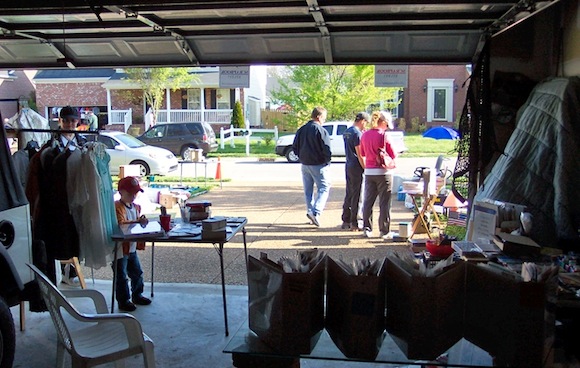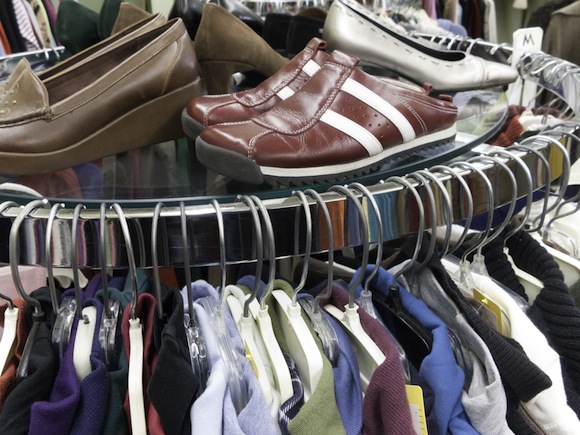Let’s face it: We live in a packrat nation.
According to a study by market research firm NPD Group, the average American home contains $7,000 worth of unused items. Multiply that by a storage unit or two, and you could be sitting on a first car for your teenager, a year or two of college tuition for your high school grad or even a down payment on a house for the twentysomething in your basement.
To help turn your trash into cash, we’ve enlisted the help of specialists in your three most fruitful options: garage sales, online selling and auctions.
Whatever you no longer need, here are three ways to sell it.
1. Conduct a Garage Sale.
Kathy Ozzard Chism, author of “Garage Sale Success Secrets,” has been dubbed “the sourceress” of garage sales. The daughter of an antiques appraiser, Chism said her garage sales “average between $400 and $2,000 a sale, even with $5 to 25-cent items.”
What’s her top tip? “Think like a department store,” she said.
That means:
- Set a date three months in advance.
- Price everything. “If it’s a button, put 20 of them in a bag with a price on it,” she said.
- Clean everything.
- Use tablecloths for a fresh, organized appearance. Paper is fine.
- Group items by table. “You don’t see sweaters displayed with appliances at Macy’s,” she said.
- Put eye-candy out front to pull in shoppers.
- Enlist and train your helpers. You want them personable, not chatty, and focused on selling.
- Embrace neighborhood sales to split the advertising costs and attract more shoppers.
- Sponsor a charity. Chism’s favorites include animal rescue causes and a Ugandan village.
What’s the biggest garage sale mistake?
“People hosting garage sales who don’t smile and engage with their customers,” Chism said. “Don’t be afraid. Remember, we’re all salespeople. You’ve been selling you all your life, whether to your spouse, your friends, your employers—and you’re good at it.”
2. Cash In Online.
Australian Alex McClafferty faced a formidable task to liquidate his household stuff three weeks before moving stateside to marry an American. Frustrated by garage sales, he turned to his buddy Johnny Mean, who helped him get rid of stuff online through Craigslist, eBay and Gumtree. He wound up with $3,000 and turned his hard-earned lessons into a how-to book, “From Trash to Cash.”
Unlike scattershot garage sales, online selling involves targeted marketing. McClafferty’s buddy Johnny quickly schooled him on how to write ads from the buyer’s point of view, cross-sell related items and, most importantly, allow his personality to shine through.
Displaying personality “really resonates with people, because everyone else who is listing their stuff online is just very transactional,” he said. “If you have a bit of fun with it, it kind of sells itself.”
McClafferty would arrange face-to-face meetings with interested buyers in the middle of the day at a well-trafficked café. He cautions women to always be accompanied by “your biggest, scariest-looking friend” when showing immobile items like furniture.
“Inviting a stranger into your home is basically inviting danger into your home,” he said.
If you have the time, there are dozens of online sites for selling all manner of things, including:
- Chairish for furniture.
- Shopify for art, crafts and clothing.
- Bookscouter for books.
- Nextworth for electronics.
- TheRealReal for high-end shoes and clothes.
As for online auction powerhouse eBay, McClafferty recommends shelling out more money for a featured ad.
“Those really do pay off, because they get a lot more eyeballs on your ad, which means more qualified buyers, which usually drives the price of your product up,” he said.
3. Work With Consignment Shops and Auction Houses.
Appraiser Greg Strahm, who co-owns Treasure Quest Appraisal Group of Hobe Sound, FL, offers his clients a peek into the inner workings of consignment and auction houses. He said that although eBay has hurt the value of some items by increasing the supply of some collectibles, the worldwide audience that can participate in live auctions online has driven up the value of others.
A good appraiser not only will give you rough estimate of an item’s worth, but he or she also will tell you how to come out ahead by placing it with:
- A major auction company like Christie’s or Sotheby’s.
- A secondary auction house where regional items may fetch more.
- A weekly auction where box lots are common.
- A local consignment shop.
Auction commissions can range from 5 percent to 35 percent, while consignment typically is a 50-50 split.
Strahm said consignment shops hold one advantage over live auctions: “The consignment shop can ask whatever they want and work down. Auctions work just the opposite.”
Whichever avenue you choose, Strahm suggests doing your homework before moving forward.
“Don’t just take somebody’s word that they’re going to be able to sell something,” he said. “Ask for credentials and references.”






